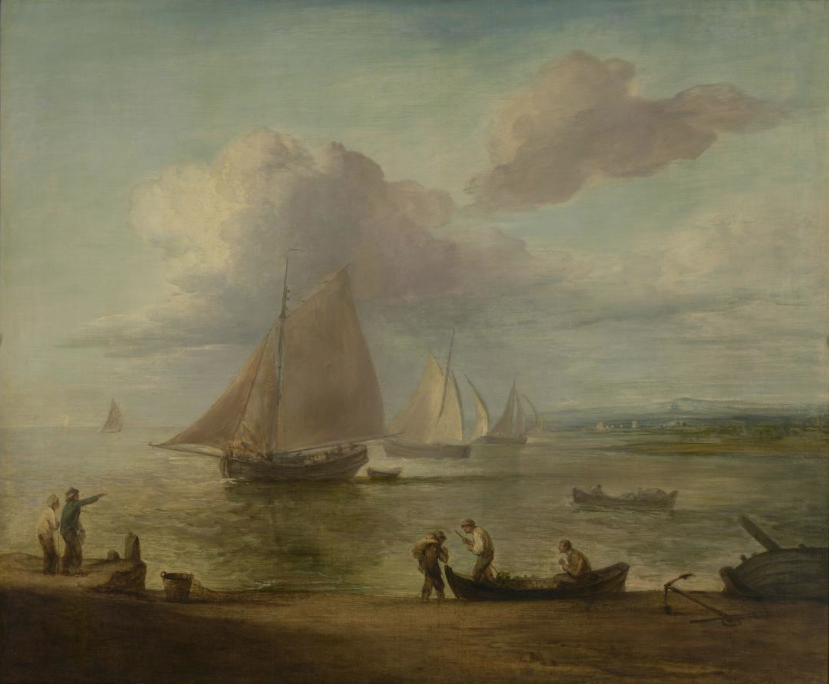In 1783 Thomas Gainsborough exhibited one of his few seascapes at the Royal Academy. During the exhibition the young Edward Francis Burney, a nephew of the famous musicologist Charles Burney and cousin to the writer Fanny Burney, took detailed sketches of many of the exhibits including the seascape.
His sketches form a rare visual record of the displays in London during the early 1780s and this collection of drawings, now in the Huntington Library in San Marino in California, is surprisingly little known.
The painting exhibited at the Academy as no 240 has always been associated with a canvas in the National Gallery of Victoria in Melbourne, Australia, but there are differences between the drawing and the painting that need to be explained.
When Gainsborough’s painting was exhibited it was entitled A Seapiece, a calm and in Burney’s sketch the centerpiece is a ship — more correctly a Brigg — fitted with three flapping sails on its main mast which creates the apex to a series of compositional triangles with their bases resting on the line of the harbour wall at the bottom of the picture.
In addition to the seascape and two portraits he commissioned from Gainsborough in 1783, he probably purchased a pair of landscape paintings for the house shortly before his death in 1787.
On the right is the coast and in the foreground figures go about their business silhouetted against the water. Presumably the first owner of the painting, Robert Palmer, saw the canvas in the exhibition before it was returned to the artist’s studio in Pall Mall.
Palmer was the principal agent to the Duke of Bedford whose grandfather had commissioned a number of paintings from Gainsborough in the 1750s and 1760s and with an income estimated at £4000 per annum, Palmer was able to acquire his own estate in Berkshire, where he built a new house Holme Park during the 1780s, and he was buying Gainsborough’s work to decorate its principal rooms.
Indeed, in addition to the seascape and two portraits he commissioned from Gainsborough in 1783, he probably purchased a pair of landscape paintings for the house shortly before his death in 1787. Perhaps it was at his suggestion that Gainsborough altered the seascape. A painting in the National Gallery in Victoria shares many features with Burney’s sketch, but not all of them.
The principle ship in the canvas appears to be a Ketch and a similar tall ship at anchor towards the horizon has disappeared and been replaced with two similar yacht‐like vessels sailing dangerously close to the coast. The scudding clouds show that a stiff breeze now fills their sails but the surface of the water remains calm enough to pay lip service to the published title of the painting.

Felton Bequest (1948) National Gallery of Victoria, Melbourne
This digital record has been made available on NGV Collection Online through the generous support of digitisation champion Ms Carol Grigor through Metal Manufactures Limited
Gainsborough is an artist who was always adapting his work and adjusting the details in his paintings to create a more nuanced balance in his compositions.
There is of course a possibility that Gainsborough painted two canvases. The one copied by Burney at the Royal Academy could have been destroyed, or it could hang undiscovered and unrecognized in an unchartered private collection, and the canvas now in Melbourne. It is only by examining the canvas itself that it is possible to resolve these questions and happily I have been able to do that. Presently I have a MacGeorge Honorary Fellowship at the University of Melbourne and I have examined the painting very closely.
Disturbances in the paint surface show that there was only ever one canvas and that Gainsborough made extensive alterations to the painting that now hangs in the National Gallery of Victoria. No doubt X‐ray photographs would show the changes in as much detail as Burney shows in his drawing. Gainsborough is an artist who was always adapting his work and adjusting the details in his paintings to create a more nuanced balance in his compositions.